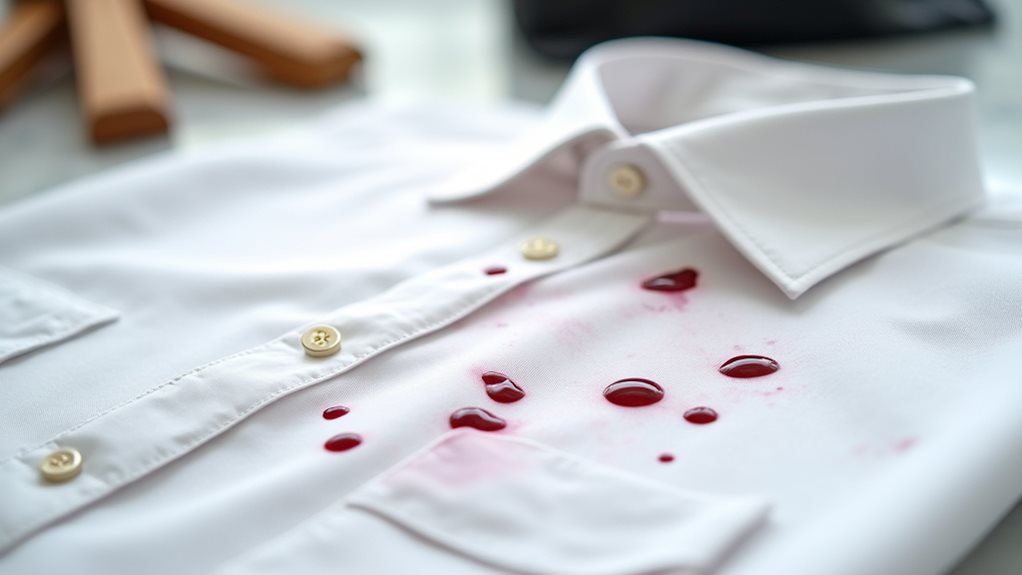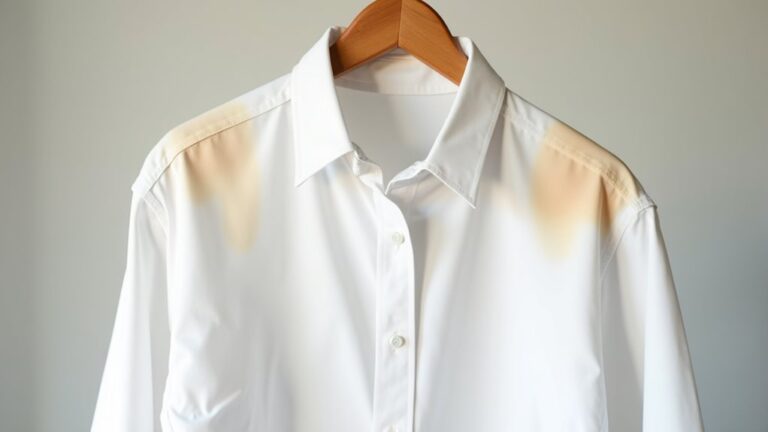Yes, dry cleaning can effectively remove blood stains, especially when you act quickly! Professional cleaners use specialized enzyme-based treatments that break down blood proteins, something I learned the hard way after ruining a silk blouse with home remedies. Fresh stains respond much better than set-in ones, and dry cleaners have sophisticated solvents like perchloroethylene that penetrate deep into fabric fibers. The key factors are timing, fabric type, and professional expertise – discover how these elements work together for best results.
How Dry Cleaning Tackles Blood Stains
When I first discovered blood on my favorite silk blouse after a cooking mishap (apparently, I’m more dangerous with a paring knife than I thought 😅), I learned that dry cleaning isn’t just some mysterious process where clothes disappear behind a curtain and emerge magically clean.
Professional dry cleaners actually use a sophisticated approach to tackle blood stains, starting with enzyme-based spot cleaners that specifically target protein-based stains like blood, sweat, and food residue.
The dry cleaning process then employs specialized solvents, particularly perchloroethylene, which penetrate deep into fabric fibers to dissolve organic stains that water-based cleaning can’t touch.
When you treat stains promptly and communicate details about the incident to your cleaner, stain removal becomes greatly more successful.
However, fresh blood stains are generally much easier to remove than those that have had time to set into the fabric permanently.
Why Blood Stains Require Professional Treatment
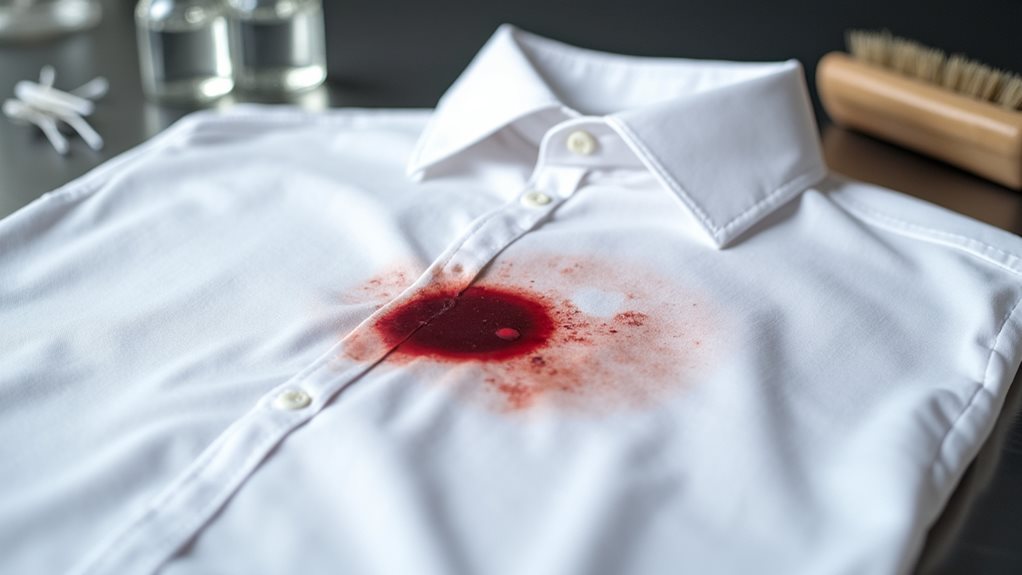
Blood stains aren’t just stubborn because they’re red and dramatic-looking, though I’ll admit there’s something particularly defeating about watching that bright crimson mark mock you from your clothing.
These stains demand respect because they’re protein-based, which means they literally bond with fabric fibers like they’re planning to stay forever.
Blood stains bond with fabric fibers at the molecular level, creating stubborn protein-based connections that resist ordinary cleaning methods.
Professional dry cleaners understand this chemistry battle better than we do, wielding specialized enzyme-based treatments that actually break down those stubborn proteins instead of just pushing them around.
Quick action helps, but even then, perchloroethylene and professional spotting solutions offer a higher success rate than our desperate home remedies.
However, fresh blood stains are generally much easier to remove than set-in stains that have had time to bond completely with the fabric.
Trust me, I’ve learned this lesson the hard way!
The Science Behind Enzyme-Based Blood Stain Removal
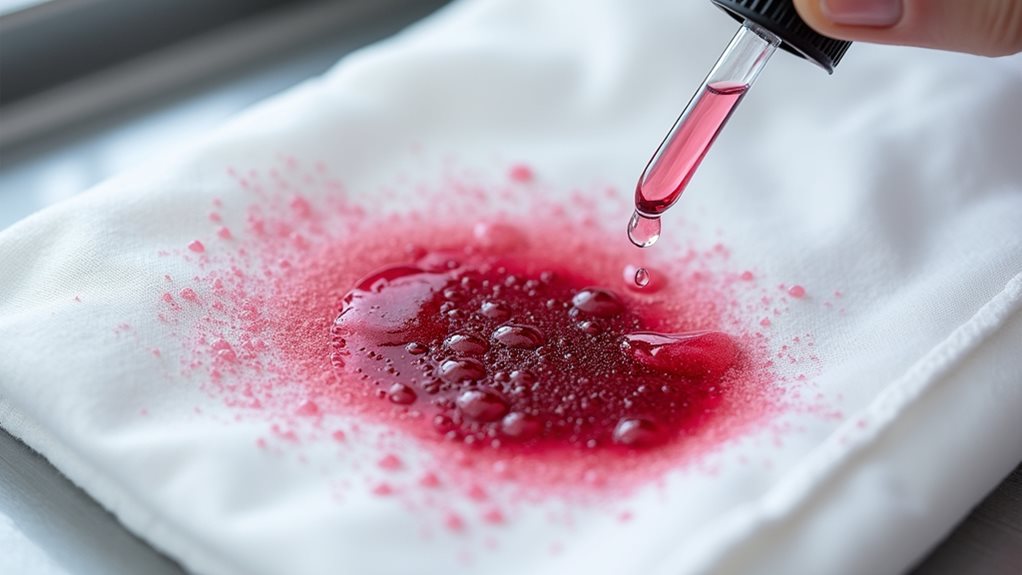
When you’re staring at a stubborn blood stain on your favorite shirt, you’re fundamentally looking at proteins that have bonded with fabric fibers.
Here’s where enzyme-based cleaners become your best friend by literally eating away at those protein structures. These specialized enzymes, particularly proteases, work like tiny molecular scissors that slice through protein chains, breaking them down into smaller fragments that can be easily lifted away from the fabric.
The key thing I’ve learned from my own laundry disasters is that timing matters tremendously—fresh blood responds beautifully to enzyme treatment, but once it sets and dries, those proteins become stubborn little anchors that require more aggressive intervention.
While dry cleaning excels at removing oil-based and grease stains, blood is a water-based stain that presents unique challenges for traditional dry cleaning solvents.
How Enzymes Work
The microscopic warriors in enzyme-based cleaners work like tiny molecular scissors, methodically snipping apart the complex protein chains that make blood stains so stubbornly persistent on your favorite garments.
When you apply these proteases during the dry cleaning process, they’re fundamentally performing molecular surgery, targeting hemoglobin and other blood proteins with laser-like precision.
I’ve watched countless clients breathe sighs of relief when these cleaning agents successfully tackle what seemed like impossible stains 😊.
The beauty lies in how enzymes work differently from harsh chemicals – they’re gentle enough for delicate fabrics yet powerful enough for serious stain removal.
Think of them as your fabric’s best friend, breaking down complex proteins into harmless fragments that wash away easily, leaving your clothes looking fresh and undamaged.
Professional dry cleaners combine enzyme treatments with chemical solvents to maximize their effectiveness against protein-based stains like blood, which regular water-based washing often struggles to eliminate completely.
Protein Breakdown Process
Although I’ve spent years watching enzyme cleaners work their magic, understanding exactly how proteins break down during this process still fascinates me every single time I witness it in action.
When you’re dealing with blood stains, you’re fundamentally battling protein-based molecules that have bonded with your fabrics, and enzyme-based cleaners become your best allies in this microscopic war.
These specialized enzymes literally slice through protein chains like tiny molecular scissors, breaking them into smaller fragments that can’t maintain their grip on fabric fibers.
Dry cleaners understand this cleaning process intimately, which is why they’ll often pre-treat stubborn blood stains with enzymatic solutions before introducing their primary solvents, guaranteeing complete stain removal without compromising your garment’s integrity.
This approach proves especially valuable for delicate materials like silk and wool, where traditional home washing methods could cause permanent damage to the fabric structure.
Treatment Time Factors
Timing becomes absolutely critical when you’re hoping to salvage a blood-stained garment, because I’ve learned through countless mishaps that every minute counts in this delicate dance between enzymes and stubborn proteins.
Treatment time factors directly influence removal success, especially when enzyme-based cleaners encounter those pesky blood stains that seem determined to become permanent residents.
Here’s what happens during different timeframes:
- Fresh stains (under 30 minutes): Enzymes attack proteins while they’re still vulnerable.
- Set-in stains (1-24 hours): Proteins begin bonding with fabric fibers.
- Old stains (days/weeks): Blood becomes increasingly stubborn and resistant.
- Ancient stains (months): Nearly impossible without aggressive treatments.
Professional dry cleaners understand these windows perfectly, adjusting their approach for delicate materials while maximizing stain removal efficiency through strategic timing. Unlike oil-based stains which respond well to the chemical solvents used in dry cleaning, blood requires specialized enzyme treatment that works best within specific timeframes.
Factors That Affect Blood Stain Removal Success
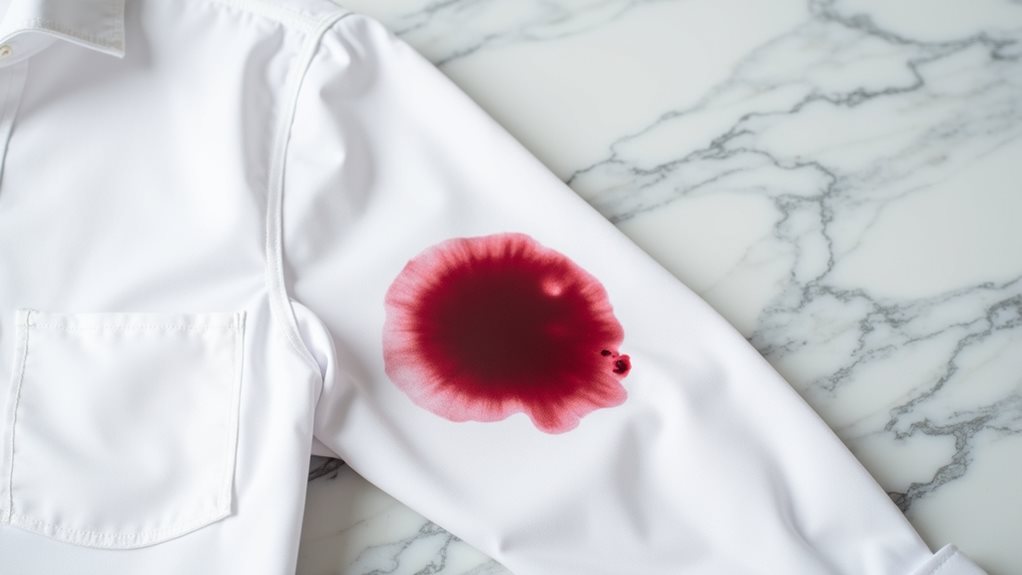
You’ve probably noticed that some blood stains disappear with minimal effort while others seem permanently etched into your favorite shirt, and honestly, I learned this the hard way after ruining a beloved sweater by waiting three days to address a nosebleed incident 🩸.
The age of your blood stain becomes your biggest enemy or ally in this battle, because fresh blood responds beautifully to treatment while dried, set-in stains require the patience of a saint and multiple professional attempts.
Your fabric type also plays favorites in this process, since sturdy cotton handles aggressive cleaning like a champ, but delicate silk or wool demands the gentle touch of a skilled dry cleaner who knows exactly which enzymes won’t destroy your garment’s integrity.
Unlike sweat stains that resist dry cleaning due to their water-based nature, blood stains may respond better to the chemical solvents used in professional dry cleaning processes.
Age of Blood Stain
When it comes to blood stain removal, the clock starts ticking the moment that red droplet hits your favorite shirt, and I learned this lesson the hard way during my son’s first nosebleed incident at his school play.
The age of blood stain dramatically affects whether dry cleaning can remove it successfully, because fresh stains haven’t bonded deeply with fabric fibers yet.
Here’s what happens as time passes:
- First few hours: Proteins remain loose, giving you the highest success rate
- 24-48 hours: Blood begins coagulating, making removal more challenging
- Several days: Proteins bond firmly with fabric fibers
- Weeks or months: Stains become nearly permanent, even for professional cleaners
Immediate treatment is your best friend when dealing with protein-based stains—don’t procrastinate! 😅
Professional dry cleaners often recommend pre-treatment techniques for blood stains before the main cleaning process to maximize the chances of complete removal.
Fabric Type Considerations
While age matters tremendously in blood stain removal, the fabric type you’re dealing with can make or break your dry cleaner’s efforts. This is something I discovered when my daughter’s silk blouse met an unfortunate encounter with a paper cut during her piano recital.
Delicate fabrics like silk and wool require gentle handling during the dry cleaning process, which can limit cleaning effectiveness compared to sturdier materials. Cotton and polyester typically handle enzyme-based treatments better, giving your dry cleaner more aggressive options for blood stains.
The irony? Those expensive delicate fabrics that need the most careful treatment are often the hardest to restore perfectly. Your dry cleaner’s success largely depends on matching the right stain removal technique to your specific fabric type.
Blood falls into the category of protein-based stains, which professional dry cleaners often find more challenging to remove completely compared to oil-based stains, especially when the blood has aged and bonded more permanently to the fabric fibers.
What to Do Immediately After a Blood Stain Occurs
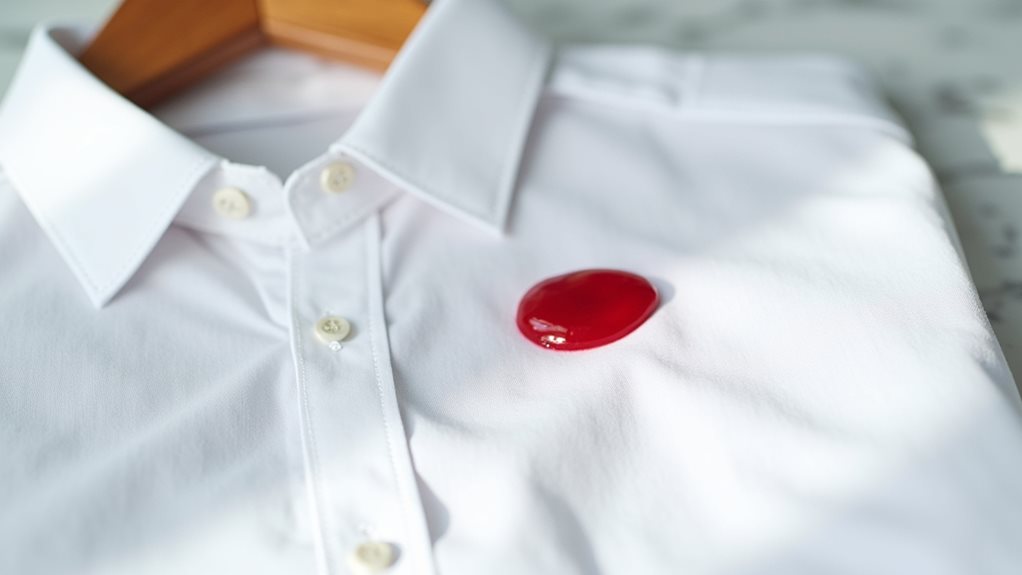
Since blood stains have this sneaky way of happening at the worst possible moments—like when you’re wearing your favorite white shirt to an important meeting—knowing how to react immediately can mean the difference between saving your garment and saying goodbye to it forever.
Trust me, I’ve learned this lesson the hard way more times than I’d like to admit! Here’s your emergency action plan:
- Act quickly before the stain sets permanently into fabric fibers
- Rinse with cold water to lift blood before it bonds
- Gently blot with a clean cloth or paper towel—no rubbing!
- Apply enzyme-based stain remover or head straight to a dry cleaner
While dry cleaning excels at removing oil-based stains, blood requires pre-treatment since it’s a water-based stain that may not be completely removable depending on how long it has set.
When Blood Stains Become Permanent
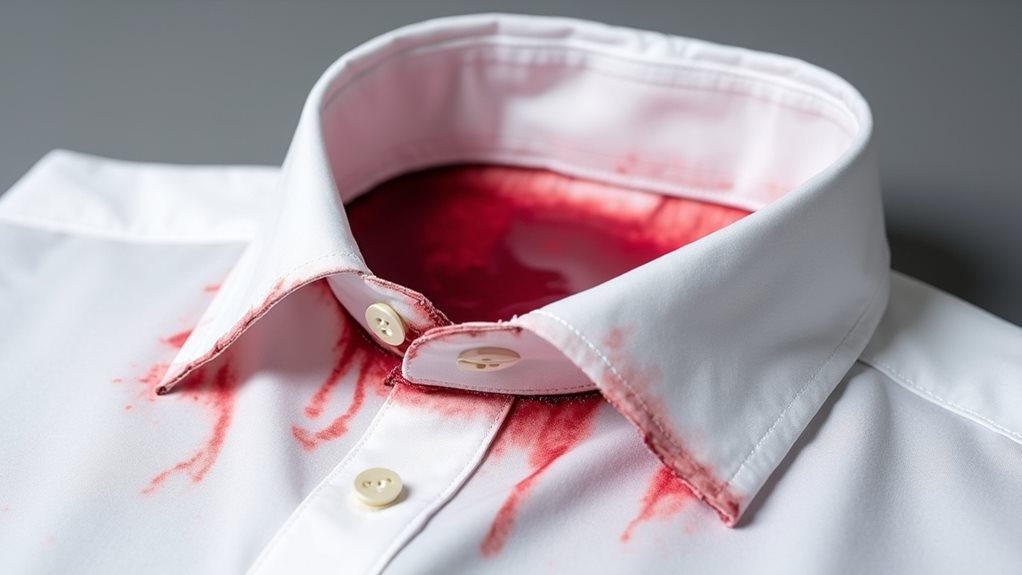
Unfortunately, despite our best efforts and immediate action, there comes a heartbreaking moment when we’ve to face the reality that some blood stains simply aren’t going anywhere—they’ve officially moved in and made themselves at home in your fabric fibers.
Blood stains become permanent when they’re not treated promptly, typically after 24-48 hours when proteins form unbreakable bonds with your fabric. High temperatures from washing or drying are absolute killers here, fundamentally cooking the proteins into the material forever 😔.
Even professional enzymatic cleaners struggle against older stains, especially on delicate fabrics that can’t handle aggressive treatment.
Stain age becomes your biggest enemy—what could’ve been saved yesterday might be impossible today.
Comparing Dry Cleaning Vs Home Remedies for Blood Stains
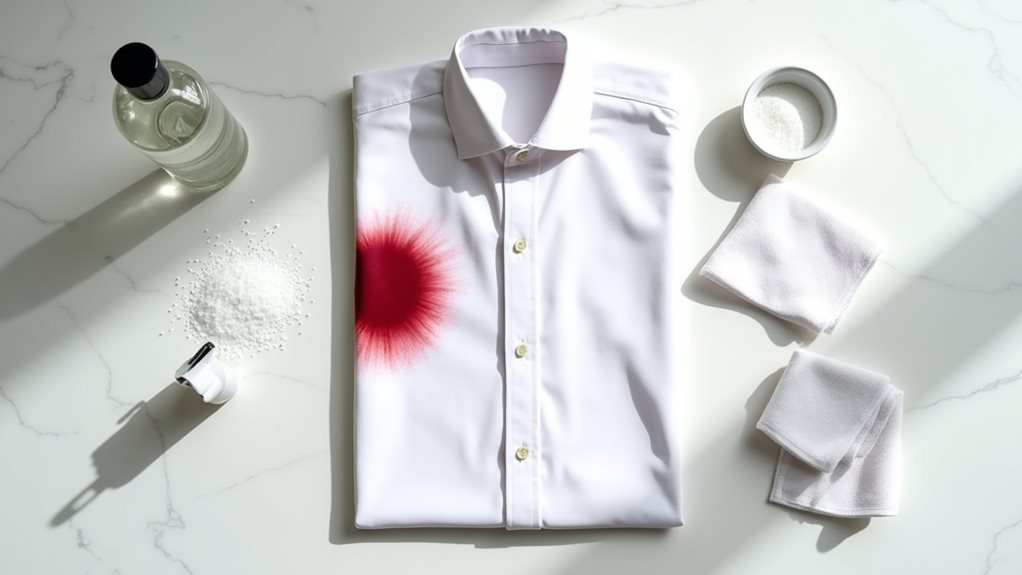
When you’re staring down a blood stain and weighing your options, the choice between grabbing household supplies or heading to the dry cleaner can feel like choosing between a DIY YouTube tutorial and calling in the professionals—both have their place, but the stakes determine which route makes sense.
Here’s what you’re really comparing:
- Fresh stains: Cold water and salt work surprisingly well at home.
- Set-in stains: Professional treatment with enzyme-based cleaners dominates.
- Fabric penetration: Specialized solvents reach deeper than hydrogen peroxide ever could.
- Success rates: Dry cleaning service effectiveness consistently outperforms home remedies.
The brutal truth? While home remedies might save your favorite shirt from a paper cut mishap, older blood stains need those fancy perchloroethylene solvents that professional stain removal services wield like magic wands.
Maximizing Your Chances of Complete Blood Stain Removal
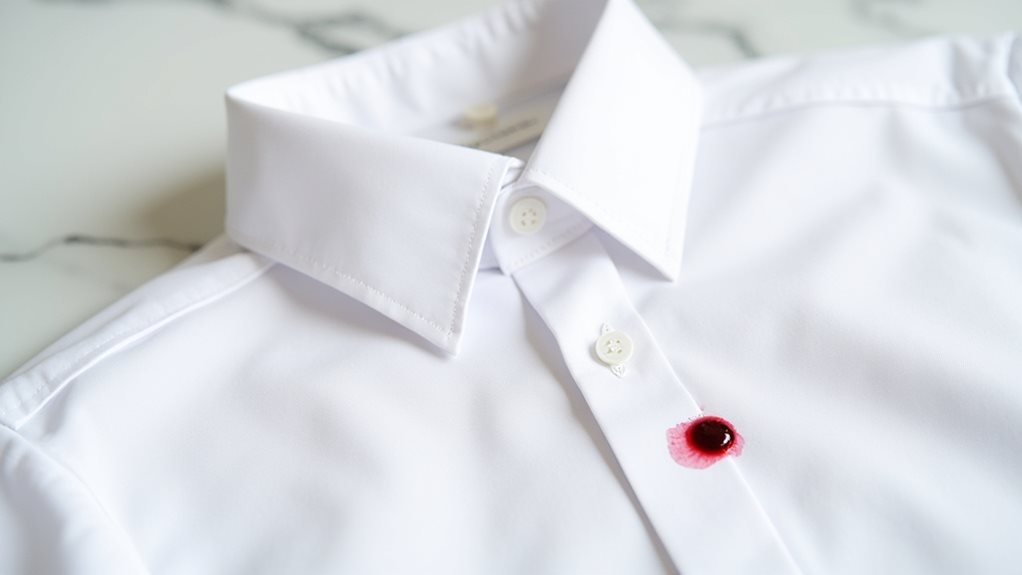
While timing isn’t everything in life, it’s pretty much everything when you’re dealing with blood stains, and I learned this the hard way after letting my daughter’s soccer uniform sit in the hamper for three days after a particularly brutal game where she looked like she’d wrestled a tomato 🍅.
Here’s what I discovered: act quickly because fresh blood stains surrender much easier than their stubborn, set-in cousins.
When you visit the dry cleaner, spill the details about your stain’s origin story and any DIY stain treatments you’ve attempted, because dry cleaners use this intel to choose the perfect enzyme solution that effectively removes protein-based disasters.
It’s crucial to recognize that heat will set the stain permanently, so resist that hot water temptation.

